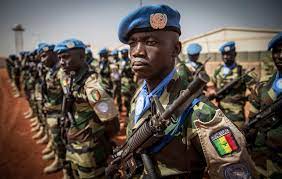APA – Bamako (Mali) – The withdrawal of the United Nations Multidimensional Integrated Stabilisation Mission in Mali (MINUSMA), scheduled for December 31, is entering its final phase.
The second phase of the withdrawal, which began on September 1 and involved the closure of eight bases, is facing enormous difficulties.
This is due to the resumption of hostilities between the signatories to the agreement, the intensification of insurgent attacks against the withdrawal convoys and tensions with the authorities over the process.
The MINUSMA base in Tessalit, a town in the Kidal region, has been handed back to the Malian authorities.
It has been the object of much covetousness between the Malian armed forces and the CSP-PSD rebels, who have been engaged in deadly clashes for some time.
The UN mission in Mali said it had “completed the accelerated withdrawal of all its troops and civilian personnel from its base in Tessalit on October 21, 2023.”
While some peacekeepers and their light equipment had to be chartered, others had to travel by road to Gao, a journey of more than 550 kilometres.
The departure from Tessalit marks the first closure of a MINUSMA camp in the Kidal region of northern Mali, at a time when the security situation is deteriorating, putting the lives of hundreds of civilians and uniformed personnel at risk. On October 19, a MINUSMA aircraft was hit by small arms fire as it landed in Tessalit. The incident caused considerable alarm, although there were no casualties and no major damage to the aircraft.
After Tessalit, MINUSMA closed its base in Aguelhok, another town in the Kidal region. At present, only the town of Kidal remains, where MINUSMA is expected to close its base in the next few days. The plan was to close it a little later, but given the very precarious security situation, MINUSMA could not wait any longer.
The main concern today is the mission’s equipment, which could not be moved by air. Even the convoys that left by road could not transport large amounts of equipment without risking being targeted. As a result of this accelerated withdrawal, MINUSMA indicated that it had no choice but to leave some of its equipment on the ground.
This is a situation that, according to the UN mission, could have been avoided “if the 200 trucks held up in Gao since 24 September due to travel restrictions had been allowed to proceed to the Kidal region to collect and transport equipment from the three MINUSMA bases as part of the Mission’s overall withdrawal.”
Rather than leaving its equipment as it is, this accelerated withdrawal has forced MINUSMA to “destroy,” “deactivate” or “decommission” it.
Their equipment included vehicles, ammunition, generators and other goods. The Mission states that these assets “could not be returned to the troop-contributing countries to which they belonged or redeployed to other United Nations peacekeeping missions.”
This has resulted in significant material and financial losses.
It should be recalled that with the closure of these two bases in the Kidal region, in addition to that of Douentza in the Mopti region, which took place at the end of last week, the Mission now has only 5 bases out of the 12 it had previously.
According to Resolution 2690 adopted by the UN Security Council on 30 June, MINUSMA must withdraw from Mali by 31 December at the latest.
Despite the obstacles and impediments associated with the withdrawal process, it intends to meet this deadline.
MD/te/lb/as/APA


